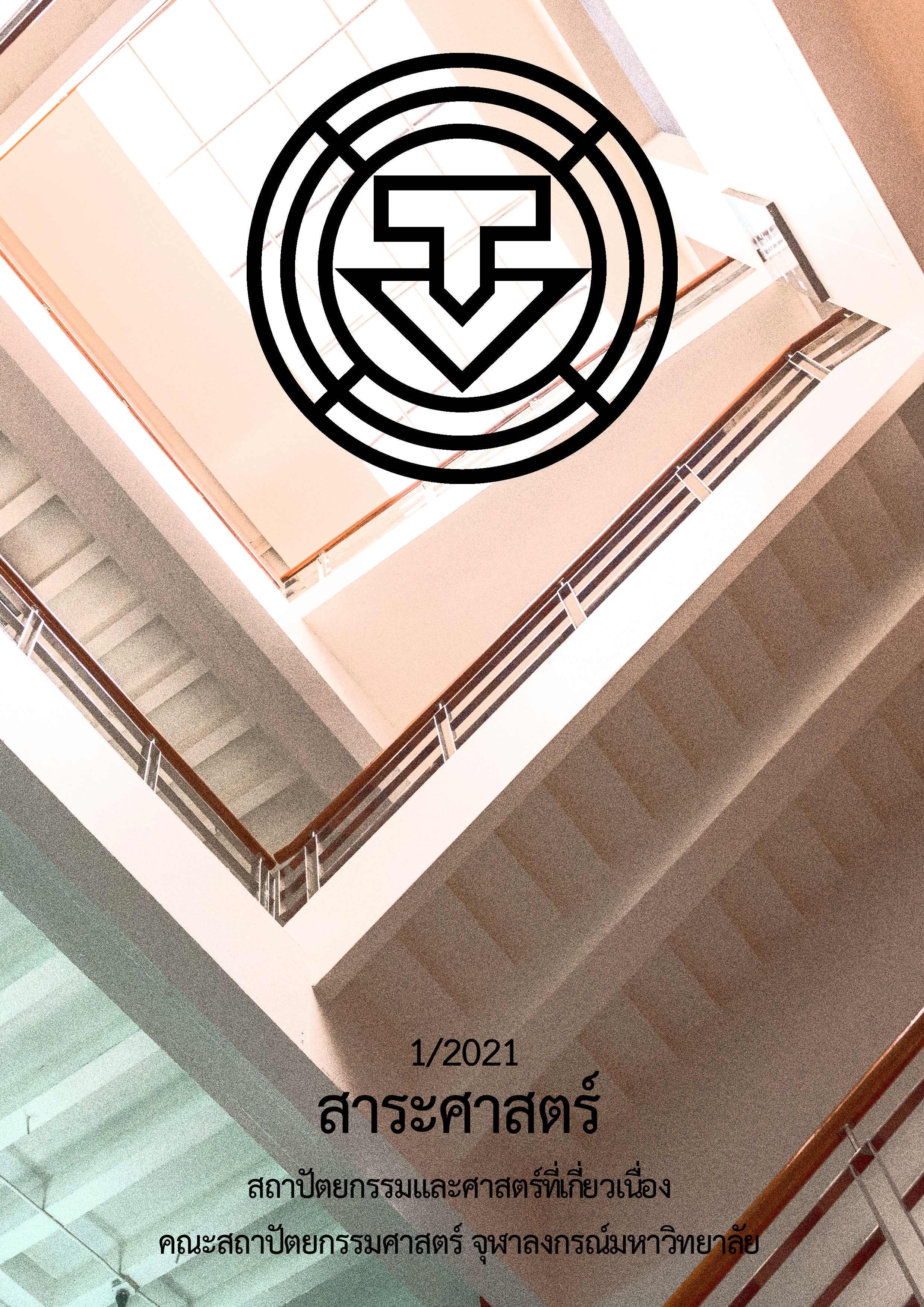Morphological Transformation of Klong Ong-Ang Community and Saphanhan Community Morphological transformation of Klong Ong-ang community and Saphanhan community
Main Article Content
Abstract
Khlong Ong-ang Community and Saphanhan Community Located on the southwest corner of the outer Rattanakosin Island of Bangkok. With an important historical Chinese settlement and consists of important physical components of the city. From the current area survey found that Khlong Ong-ang and Saphanhan community area have changed quite a bit or still have some parts remain. While nearby areas in the same context continuously change.
The objective of this study is to analyze and evaluate the land transformation and usage pattern of Khlong Ong Ang and Sapanhan communities. By studying data on the changes in physical components such as land plots and traffic routes from historical documents and land title deeds of the community. From the start of the settlement until the present, field survey, personal survey and compares data to analyze data and find answers.
From the study in the study area, it is found that (1) the land allocation form of Khlong Ong-ang community and Saphanhan community consists of three forms which are (1.1) the plot of land remains the same (1.2) Allocate new land plots and (1.3) the form of a land plot mix All three forms have the characteristics of medium and small plots of land scattered throughout the community area, making development in the form of combined plots difficult and (2) The physical factors that affect the change of community area are land pictures The development and allocation of land plots for communities has resulted in changes in traffic routes, resulting in both public and private ownership in servitude or semi-servitude. And buildings to maintain the original characteristics and develop into a commercial building to increase the usable space As well as other social, cultural, and environmental factors that affect the changes in the period, which may be further studied It is the source of the diversity of community space that is currently seen. Resulting in the study leading to an evaluation to find ways to develop and conserve the community in the future.
Article Details
References
กนกวรรณ หิรัญรัตน์. (2547). เอกลักษณ์และความหมายเรื่องถิ่นในย่านชุมชนคลองโอ่งอ่าง-สะพานหัน. (วิทยานิพนธ์ปริญญามหาบัณฑิต, จุฬาลงกรณ์มหาวิทยาลัย).
เทิดศักดิ์ เตชะกิจขจร. (2542). งานศึกษาการเปลี่ยนแปลงและแน้วโน้มการพัฒนาสภาพสังคมชุมชนริมน้ำบริเวณเครือข่ายลำน้ำ คลองบางกอกน้อย. กรุงเทพฯ: ภาควิชาสถาปัตยกรรมศาสตร์ คณะสถาปัตยกรรมศาสตร์ จุฬาลงกรณ์มหาวิทยาลัย.
ธารวี งามสิริอุดม. (2552). สัณฐานการเปลี่ยนแปลงที่ดินจัดสรรขนาดเล็กในเขตศูนย์กลางธุรกิจ: กรณีศึกษาพื้นที่บริเวณถนนศาลาแดง แขวงสีลม เขตบางรัก. (วิทยานิพนธ์ปริญญามหาบัณฑิต, จุฬาลงกรณ์มหาวิทยาลัย).
นรุตม์ คุปต์ธนโรจน์. (2558). ย่านไชน่าทาวน์เยาวราช: พื้นที่นำเสนออัตลักษณ์เชิงซ้อนของวัฒนธรรมความเป็นจีนในสังคมไทยร่วมสมัย. (วิทยานิพนธ์ปริญญามหาบัณฑิต, จุฬาลงกรณ์มหาวิทยาลัย).
นิธิ ลิศนันท์. (2552). การเปลี่ยนแปลงการถือครองที่ดินในกรุงเทพฯ: กรณีศึกษาบริเวณถนนบำรุงเมือง สำราญราษฎร์ เสาชิงช้า. (วิทยานิพนธ์ปริญญามหาบัณฑิต, จุฬาลงกรณ์มหาวิทยาลัย).
แน่งน้อย ศักดิ์ศรี, ม.ร.ว., ผุสดี ทิพทัส, ชาญวุฒิ วรวรรณ, ม.ร.ว., วีระ สัจกุล, เลอสม สถาปิตานนท์, บัณฑิต จุลาสัย. (2534). องค์ประกอบทางกายภาพกรุงรัตนโกสินทร์. กรุงเทพฯ: โรงพิมพ์แห่งจุฬาลงกรณ์มหาวิทยาลัย,.
ผุสดี ทิพทัส. (2525). บ้านในกรุงเทพฯ. กรุงเทพฯ: โรงพิมพ์แห่งจุฬาลงกรณ์มหาวิทยาลัย.
เอนก นาวิกมูล. (2541). อยู่อย่างชาวสยาม. กรุงเทพฯ: แสงแดด.


